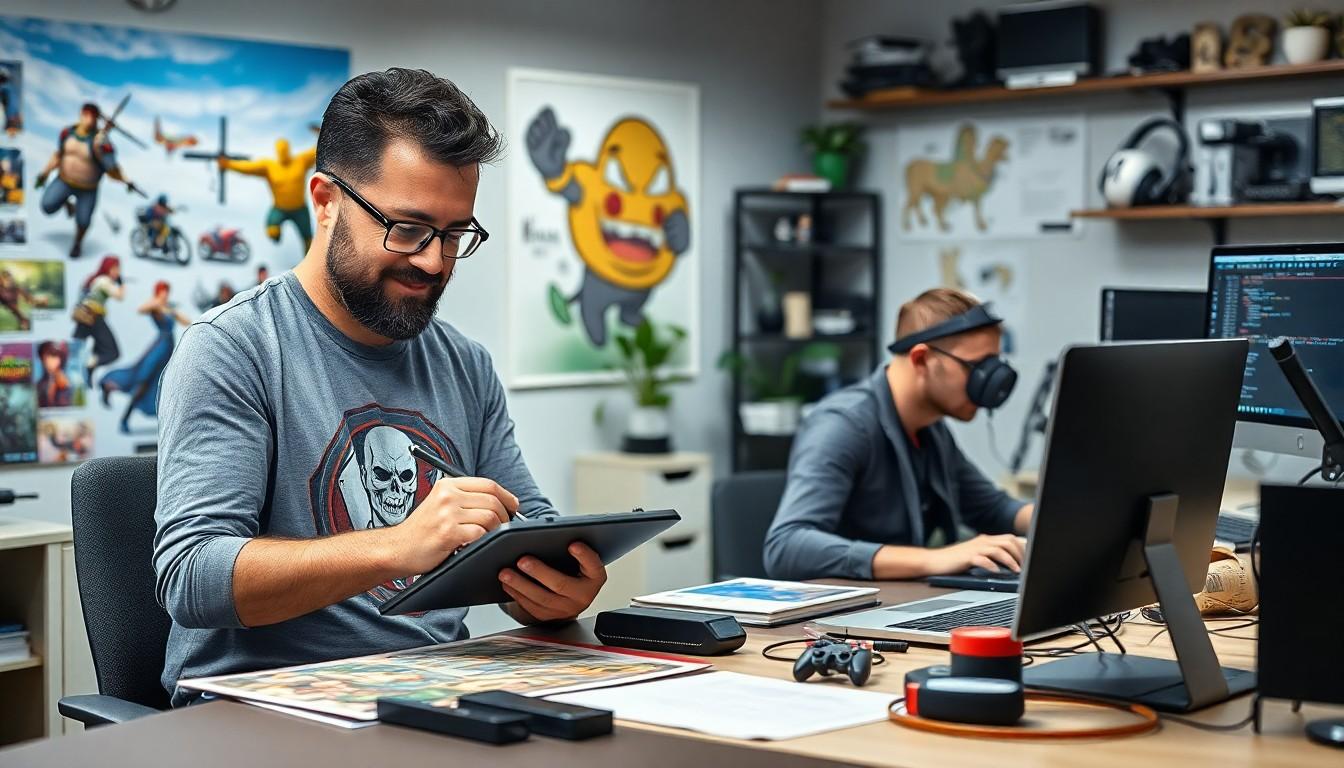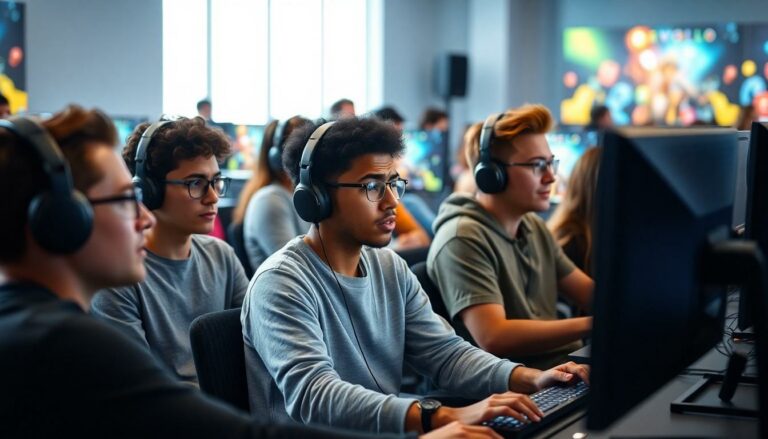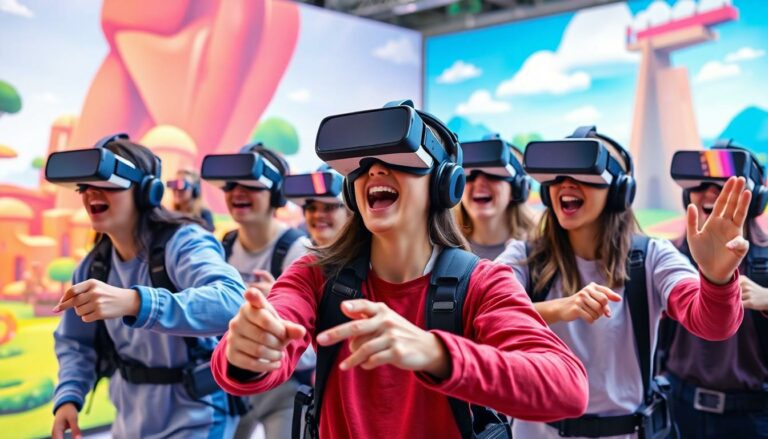In the vibrant world of gaming, two roles often get tangled in a web of confusion: game design and game development. Picture this: the game designer is the visionary artist sketching out epic landscapes and crafting gripping narratives, while the game developer is the tech-savvy wizard turning those dreams into playable reality. It’s like comparing a chef who dreams up mouthwatering recipes to the sous-chef who brings those culinary delights to life.
Game Design Vs Game Development
Game design involves creating the game’s overarching vision, focusing on elements like mechanics, story, and user experience. Designers prioritize player engagement by crafting compelling game worlds. Each decision made shapes the enjoyment and satisfaction players derive from their experience.
In contrast, game development focuses on the technical execution of design concepts. Developers translate designers’ ideas into functioning software. Their work includes programming, art asset implementation, and optimization, ensuring the final product performs smoothly across devices.
Collaboration between designers and developers fosters innovation. Designers rely on developers’ technical skills to bring ideas to life. Effective communication ensures that the vision remains intact throughout the development process.
Game design encompasses various tasks, such as creating level layouts, character development, and story arcs. Game development, on the other hand, encompasses coding languages, software tools, and testing procedures. Both disciplines require distinct skill sets, yet they unite during the game creation process.
Career paths in both areas differ significantly. Game designers may come from backgrounds in art, storytelling, or psychology. Developers often possess degrees in computer science, programming, or engineering. Each role plays a vital part in delivering immersive gaming experiences that resonate with players.
Ultimately, a successful game emerges from the synergy between game design and development. Both creators’ and coders’ expertise combine to produce engaging and functional games. Their mutual respect and collaboration enhance the overall quality of the final product.
Key Differences Between Game Design And Game Development
Game design and game development encompass distinct roles within the gaming industry. Understanding these differences clarifies how each discipline contributes to the final product.
Role Of A Game Designer
A game designer serves as the creative force behind the game. This individual shapes the overall vision, focusing on mechanics, narratives, and user experiences. Designers create characters, level layouts, and story arcs, making choices that directly impact player engagement. They also consider player psychology, ensuring the game’s emotional journey resonates with players. Collaboration with developers occurs often, enabling a seamless transition from concept to execution. Feedback from playtests refines their designs, ensuring an enjoyable and immersive experience.
Role Of A Game Developer
Game developers translate the designer’s vision into reality. They handle the technical aspects of game creation, employing programming languages and software tools. Developers implement art assets and actively test the game for performance and bugs. Their role demands proficiency in coding and a deep understanding of game engines. Problem-solving skills remain crucial, as challenges arise during development. Effective communication with designers ensures the original concept remains intact while adapting to technical constraints. Together, they forge a cohesive and functional game experience, combining creativity and technology.
Collaborative Process In Game Creation
Game creation thrives on collaboration between designers and developers, ensuring that creative visions transform into playable realities.
How Designers And Developers Work Together
Designers and developers share insights throughout the game creation process. They meet regularly to discuss concepts, design choices, and technical constraints. Feedback from developers often influences design decisions, guiding designers toward feasible solutions. Consistent communication strengthens their partnership, allowing for smoother integration of ideas. Developers bring technical knowledge, ensuring that design concepts align with programming capabilities. Ultimately, their collaboration enhances the game’s quality, resulting in a cohesive final product.
Importance Of Communication
Communication serves as the backbone of effective collaboration in game creation. Designers articulate their visions clearly, while developers express technical limitations and possibilities. Regular updates and transparent discussions prevent misunderstandings and delays. Utilizing collaborative tools aids in sharing ideas, assets, and progress. Engaging in playtests offers valuable insights for both parties, providing opportunities to refine gameplay elements. Establishing a strong communication framework leads to successful partnerships, fostering an environment where creativity and technical execution thrive.
Skills Required In Each Field
Game designers and developers require distinct yet complementary skill sets to create successful games. Understanding these skills plays a vital role in their collaboration.
Skills For Game Designers
Creativity stands at the forefront of game design. Designers envision captivating narratives and unique mechanics that resonate with players. Strong communication skills enable them to articulate ideas clearly during discussions with developers. Knowledge of player psychology helps create engaging experiences, ensuring emotional connections. Familiarity with design tools like Unity and Unreal Engine enhances their ability to prototype concepts effectively. Detail-oriented individuals excel in crafting immersive worlds, characters, and gameplay dynamics. Collaboration thrives when designers embrace feedback from playtests, refining experiences based on player interactions.
Skills For Game Developers
Technical expertise defines the game development field. Proficiency in programming languages such as C++, Java, or Python is crucial for translating design concepts into functional code. Familiarity with game engines, including Unity and Unreal Engine, allows developers to implement art assets and optimize performance. Problem-solving skills prove invaluable; they address challenges that arise during production swiftly. Strong testing abilities ensure a bug-free experience for players. Effective communication fosters collaboration with designers, keeping the vision intact while maintaining technical feasibility. A solid understanding of software development principles rounds out the skill set needed for success in this dynamic industry.
Trends In Game Design And Development
Technological advancements shape current trends in game design and development. Virtual reality (VR) and augmented reality (AR) have gained significant traction, enhancing player immersion. Game designers increasingly focus on creating interactive environments that encourage exploration and engagement.
Mobile gaming continues to expand. Developers optimize games for smartphones and tablets, ensuring accessibility across devices. Casual gaming attracts a broader audience, with simple mechanics appealing to players of all ages.
Additionally, the rise of live service games influences design strategies. Ongoing content updates and community-driven events keep players invested. Designers now prioritize player interactions and social experiences within their games.
Indie games rise in popularity as well. Smaller teams leverage innovative ideas and unique aesthetics, capturing niche markets. Platforms like Steam and itch.io provide opportunities for indie developers to showcase their work without traditional publishing constraints.
Incorporating data analytics plays a crucial role too. Game developers utilize player feedback and behavioral data to improve gameplay experiences. This data-driven approach allows for iterative design adjustments that enhance player satisfaction.
Furthermore, sustainability in game production gains attention. Eco-friendly practices are becoming standard, as both designers and developers seek to reduce their environmental impact. This trend reflects a growing awareness of corporate responsibility within the industry.
As trends evolve, cross-disciplinary collaboration strengthens. Designers and developers work together more closely than ever, integrating artistic vision with technical execution. This synergy fosters creativity and innovation, ultimately leading to more engaging and high-quality gaming experiences.
Understanding the difference between game design and game development is crucial for anyone interested in the gaming industry. While designers focus on the creative aspects of a game the developers bring those ideas to life through technical expertise. Their collaboration is the backbone of successful game creation.
As technology evolves and new trends emerge the partnership between designers and developers will only grow stronger. This synergy not only enhances the quality of games but also enriches the player experience. Embracing both roles can lead to innovative and engaging gaming experiences that captivate audiences worldwide.





